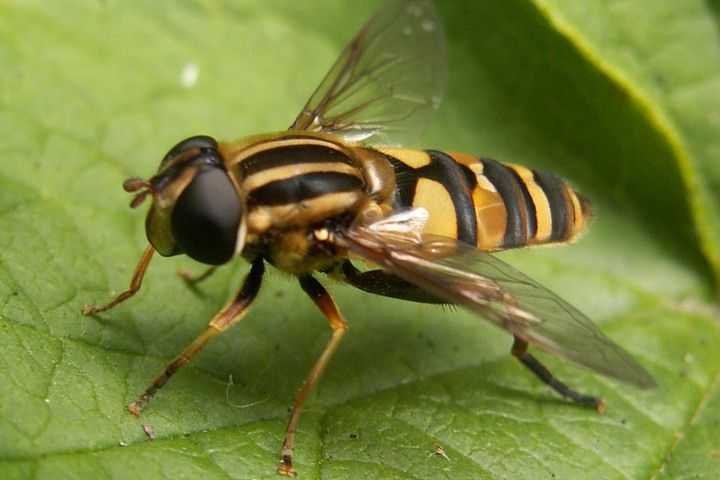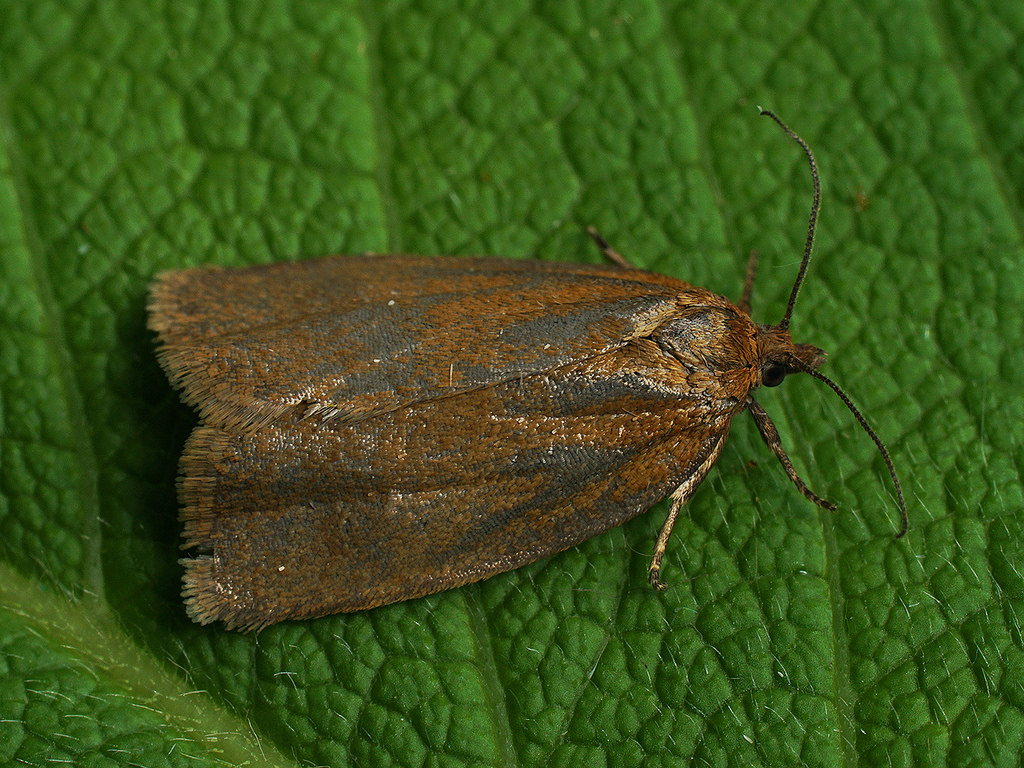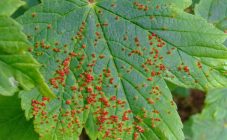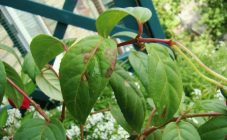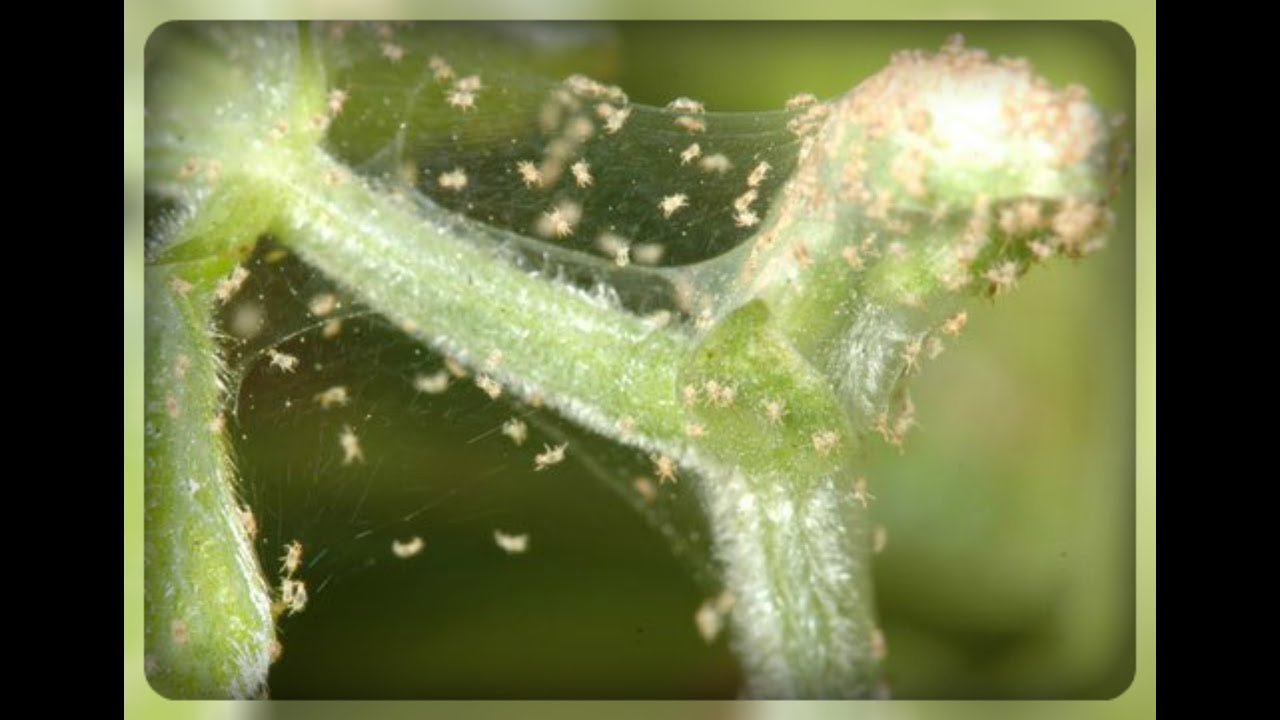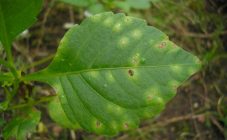Content:
Viburnum berries contain a large amount of vitamin C, as well as pectins and tannins. A decoction of berries helps to cope with angina, tonsillitis, bronchitis and pneumonia. The viburnum bark also has useful substances: from its broth you can prepare a hemostatic and antispasmodic agent, as well as a mouthwash for periodontal disease. However, insect pests can undermine the health of the tree, or even completely destroy it. Knowing what pests of viburnum exist and measures to combat them, you can take measures in time and save the tree.
The most common pests
Viburnum has many admirers not only among people, but also among insects. However, the preferences of the latter are destructive for her. The following are the pests that can cause the greatest harm to the viburnum, as well as how to get rid of them and save the plant.
Black aphid on viburnum, how to fight
These small bugs are easy to spot: they are brown, almost black, in color (less often crimson-brown) and accumulate in large quantities on the stems of the plant. They usually lay eggs in the bark of the viburnum, as well as on the branches. In the spring, the larvae hatch, begin to suck out juices and devour the young leaves of the plant. They dry and wrap over time, and the shoots change shape.
In general, aphids attack three times a year, starting in May. In this month, it is necessary to start treating the plant with insecticides. Then the larvae of aphids grow and turn into flying insects that are able to fly over to neighboring plants. In August, the aphid begins laying eggs, which will be able to successfully overwinter, despite the frost.
The measures to combat viburnum aphid include the destruction of root growth, the largest number of eggs is laid there. How can you treat viburnum from aphids? The plant should be sprayed with chemicals:
- Arrivo,
- Fury,
- Fufan or Fufanon,
- Karbaphos.
Or biological:
- Fitoverm,
- Akarin or Agravertine KE,
- Aversectin,
- Intavir.
Also, it will not be superfluous to treat the plant with a solution of laundry or tar soap.
What if the use of chemicals in the area is not possible? Folk remedies will help. For spraying, you can use decoctions made from other plants. For this, potato tops (1.2 kg of green per 10 liters of water), pepper infusion (1 kg of capsicum per 10 liters), celandine (3-4 kg of fresh celandine per 10 liters) are suitable.
It will also be useful to purchase or lure beneficial insects that destroy aphids on viburnum. This is a ladybug, a hoverfly or a goldsmith's larva. Insects will eat pests, and the viburnum will not be touched.
Green lobed moth
The caterpillar has a yellow-green color with a dark red stripe along the body, the same dots and spots. He prefers to eat only flowers, gnaw flower ovaries. It is especially active from May to July. Two generations of butterflies may appear over the summer. The moth is most often found on the Buldenezh ornamental shrub. In addition to viburnum, it can harm other garden shrubs, such as lilac and buckthorn.
Viburnum leaf beetle
Viburnum leaf beetle is a large brown beetle. Prefers to hide a clutch of eggs in young shoots of viburnum. The larvae have a black head and a dirty gray body. Some confuse the leaf beetle caterpillar with the worm. Larvae emerge from eggs in late spring and begin to eat young leaves. You can see that the leaf beetle caterpillars on the viburnum have eaten all the leaves. They are able to completely eat the leaf, leaving only the skeleton mesh instead. You can notice them on the back of the sheet: the caterpillars are held firmly and it is not so easy to shake them off.
At the beginning of summer, larvae hide underground and turn into beetles. They are yellow-brown in color. Beetles not only eat viburnum leaves, but gnaw holes in them. In this case, you can see that the viburnum leaves are in holes. Now leaf beetles live on the upper part of the leaf. After the leaves, they move to inflorescences. their actions can lead to the complete death of the plant and the crop.
Favorable weather for the leaf beetle - rain, dampness and cold. Under such conditions, the number of beetles can increase, which will bring considerable harm to the viburnum.
These parasites are capable of almost completely destroying plantings, and it is very difficult to remove them. If no action is taken, a weakened plant may not survive the winter.
To overcome this beetle, you need to remove dried and damaged shoots, as well as leaves with larvae in the fall. Process the plant in spring, when the leaves have not yet blossomed, and in August. For this, the drug Intavir is suitable: you need to spray the plant twice with an interval of 7-10 days. During the growing season, it is recommended to spray the viburnum with hot pepper infusion (a kilogram of fresh or 0.5 kg of dried chopped pods per bucket of water), infusion of tomato tops (4 kg of fresh herbs per bucket of water) or chamomile broth (3 kg of fresh or 1 kg of dried water per bucket) ). It will also be useful to remove those shoots in the spring, in which egg clutches are visible. Pruning should be removed and burned immediately.
Viburnum leafworm
The larvae of this pest are caterpillars of gray or green color, which have a yellow tint on the sides. The entire body of caterpillars is covered with light hairs. Activated in the spring. They actively eat the buds and young leaves of the plant. In addition, they wrap the leaves with cobwebs and knock them into a ball.
The caterpillars of the leafworm are capable of real sabotage: in a short period of time they can eat huge amounts of leaves and inflorescences, which negatively affects the yield. So that it does not happen that all the leaves of the viburnum are eaten by the caterpillars, you need to start fighting with them in time.
Viburnum gall midge
This parasite harms only viburnum flowers. After wintering, adults emerge from the cocoons in the upper layers of the soil and lay their eggs inside the bud. The bud is strongly deformed, increases in size and changes color to red. Because of all this, the flower does not open and the yield of the viburnum is greatly reduced.
To combat this pest, you need to loosen the soil in early spring and late autumn. Before the flowers appear in the viburnum, spray the plant with 10% Karbofos (100 g per bucket of water).
Cap moth
It is a small butterfly (wingspan up to 1 cm). The color is gray, with shiny scales on the body. The moth larvae are orange-brown in color, no more than 0.5 cm in size.For the winter, the moth makes a shelter for itself and hibernates in it, and in the spring it flies out and feeds on viburnum leaves. It pupates in June and becomes a butterfly in July.
Spring treatment of viburnum during the period of regrowth of young shoots will help to cope with moths. Suitable drugs such as Fufanon, Actellik, Iskra, Commander and Intavir.
Other pests
Less often, you can encounter a spider mite, a honeysuckle griffon sawfly, a speckled moth and a comma-shaped scabbard. To combat them, you need to treat the plant with Karbofos in May, and in August with Fufanon or Iskra.
Folk methods of struggle
Many gardeners choose not to use chemicals to control pests. And there are many folk methods: in addition to a decoction of the previously listed garden plants, spraying with a soap solution is recommended. Such a solution is prepared using laundry soap or tar. You just need to dissolve the soap in water, about 100 grams per 1 liter of water, preferably warm.
This method is absolutely safe for humans. For greater efficiency, it is recommended to add to the solution:
- soda,
- ash,
- tobacco,
- tops.
The following are the methods for preparing each solution.
Soda-soap solution
The effect of using this tool will be noticeable by the end of the day. To prepare, you need to mix soap with water (1/4 or 1/2 of a bar of soap per bucket is enough), then add soda at the rate of 1 tablespoon per liter of water. You will need about 10 tablespoons of baking soda per bucket. Mix thoroughly and spray the plant well.
Ash solution
Wood ash is highly irritating to insect skin, so it is excellent for pest control. The soapy water will help fix the ash solution to the leaves.
First you need to sift 300 grams of wood ash, add to a bucket filled with 10 liters of water and put on fire. Cook for half an hour. Then cool slightly and add 40 grams of soap.
Tobacco solution
For cooking, you need to mix 200 grams of dry tobacco leaves with three pods of hot pepper and pour everything with a bucket of water. Insist for a day. Then add 100 grams of laundry soap, 3 tablespoons of wood ash (can be replaced with cinnamon) and stir. Such a solution is able to quickly remove pests.
Leaf solution
You can use potato or tomato tops to prepare the solution. It is necessary to grind 3 kg of fresh herbs, pour 10 liters of water and leave for at least 6 hours. Then put on the stove, bring to a boil and cook for half an hour. Then cool, add 50 grams of soap and use.
Using a soap solution for spraying viburnum is safe for humans and is available to everyone. However, it is not always possible to cope with harmful insects only with the help of folk remedies. Store drugs are much more effective, but they also fail to destroy all pests the first time. For maximum effectiveness, it is worth using folk remedies in combination with store-bought ones.
Necessary prevention
To prevent viburnum diseases and to detect early signs of pests, you need to regularly inspect the plant. If the leaves began to turn black, dry or rot, holes appeared on them, you need to look for the cause and fight it.
For prevention and treatment, it will not be superfluous to treat the bushes with onion, garlic or tobacco infusion, as well as soapy water (any of those described earlier) throughout the season. As a prophylaxis of viburnum diseases, as well as for pest control, the use of insecticidal plants is perfect. It can be horse sorrel, dandelion, bitter wormwood.
It will not be possible to fully protect the viburnum, the pests can attack again, but the timely detection and destruction of harmful insects will prevent them from laying eggs.


